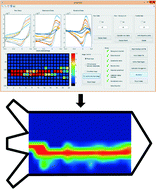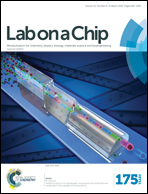Electrochemical imaging for microfluidics: a full-system approach†
Abstract
Electrochemistry is developed as a new chemical imaging modality for microfluidics. The technique is based on multipoint voltammetry using an embedded 20 × 10 miniature electrode array implemented on a customized printed circuit board. Electrode durability was enhanced by chemical modification of the electrode surfaces, which enabled continuous, stable use for over 2 months. A system-level approach enables automatic calibration, data acquisition and data processing through a graphical user interface. Following data processing, redox currents and peak positions are extracted from location-specific voltammograms and converted into pixels of an “electrochemical image”. The system is validated by imaging steady-state and dynamic laminar flow patterns of flow-confined solutions of the redox pairs Fe(CN)63−/4− or multi-redox environments that include coflowing Ru(NH3)62+/3+ solutions. The images obtained are compared with flow simulations and optical images for validation. A strategy to achieve measurements with spatial resolution smaller than the individual electrodes is also demonstrated as an avenue to enhance image spatial resolution. It is expected that this new approach to chemical imaging will expand the applicability of microfluidics in certain areas of chemistry and biology without requiring expertise in electrochemistry.


 Please wait while we load your content...
Please wait while we load your content...